
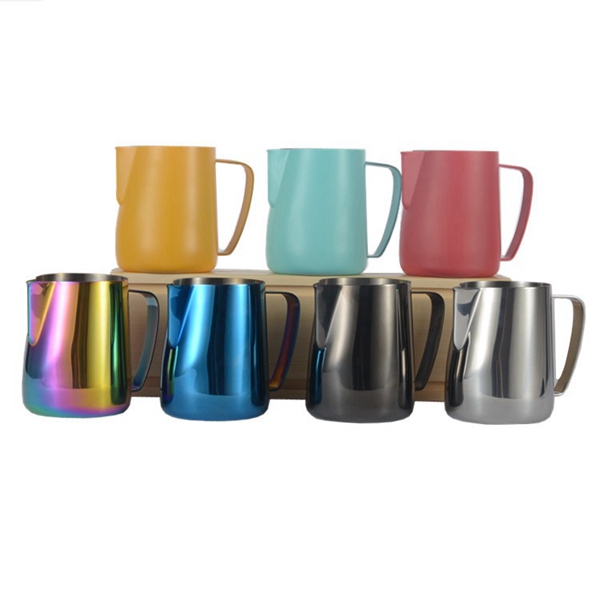
Custom Milk Jug
That's great to hear! The milk steamer sounds like a versatile and convenient tool for coffee lovers. Being able to froth milk, steam latte, and even measure and supply milk or cream is definitely a useful feature. The ability to create latte art with the included pen adds a nice touch to your coffee creations.
The use of 304 stainless steel for both the milk frothing pitcher and coffee art pen is a great choice. This material is known for its durability and resistance to damage, making them suitable for daily use. Overall, it seems like you have a reliable and quality set of tools for your coffee making needs.
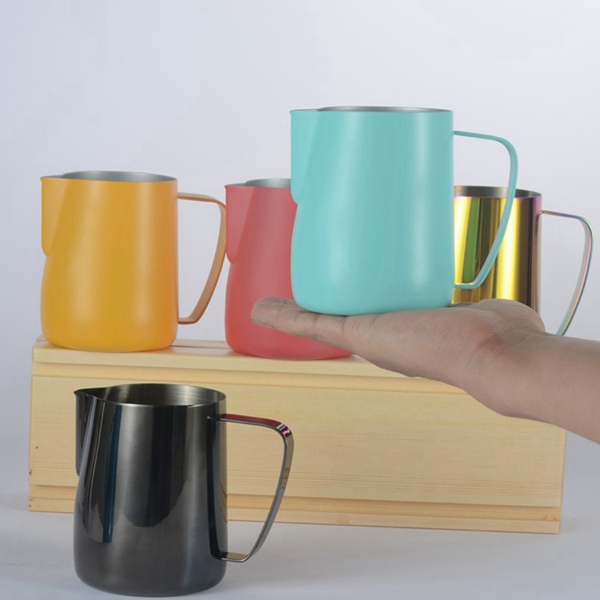
1. Versatility: A frothing pitcher can be used for various purposes, such as frothing milk for cappuccinos and lattes, as well as pouring and serving drinks.
2. Easy to use: Frothing pitchers are typically designed with a comfortable handle, making them easy to grip and pour from.
3. Control over milk texture: Frothing pitchers often come with measurement markings on the inside, allowing you to accurately measure and control the amount of milk used for frothing.
4. Pouring precision: The spout of a frothing pitcher is designed to allow for precise pouring, making it easier to create latte art or pour foam on top of beverages.
5. Durability: Frothing pitchers are typically made from high-quality stainless steel, which makes them durable and resistant to rust or corrosion.
6. Easy to clean: Frothing pitchers are usually dishwasher safe and can be easily cleaned after use.
7. Professional and aesthetic appeal: Frothing pitchers often have an elegant and sleek design, adding a touch of professionalism and aesthetic appeal to your coffee-making process.
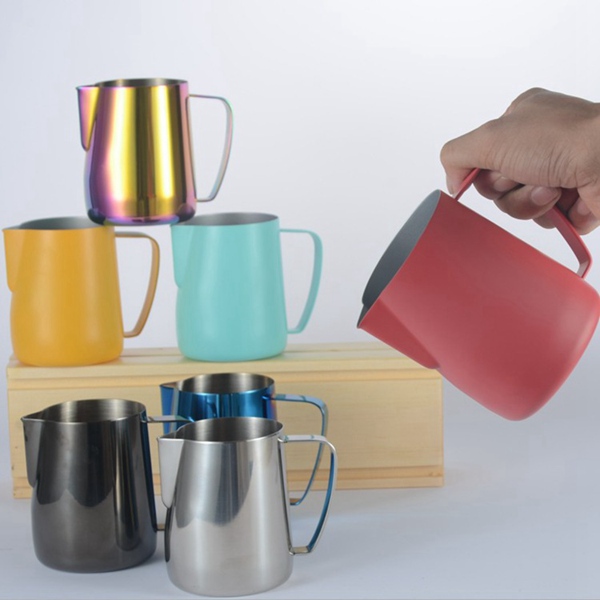
Place of Origin: China
Logo: Accept Customized Logo
OEM/ODM: Availalbe
Material: Stainless Steel
Size: As pictures
Color: Sliver/Black/White/Yellow/Blue/Green
Capacity: 350ml/600ml
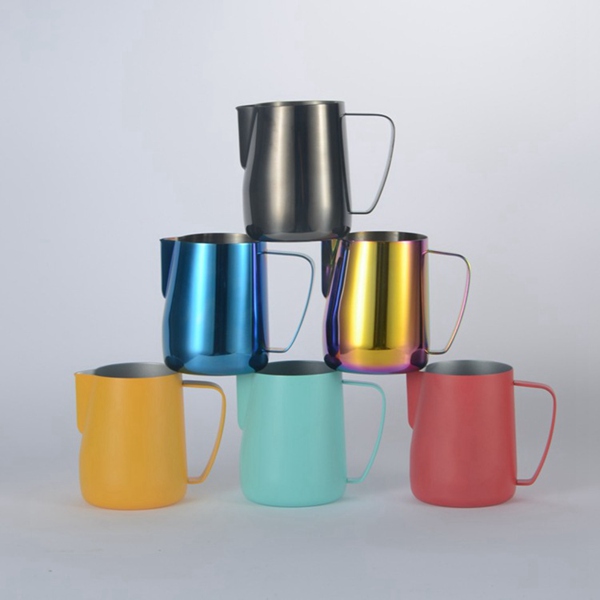
Frothing Pitcher is commonly used in cafes, restaurants, and homes for frothing milk for various coffee beverages such as cappuccinos, lattes, and macchiatos. It is an essential tool for achieving the perfect texture and consistency of frothed milk, adding an aesthetic touch to coffee drinks.
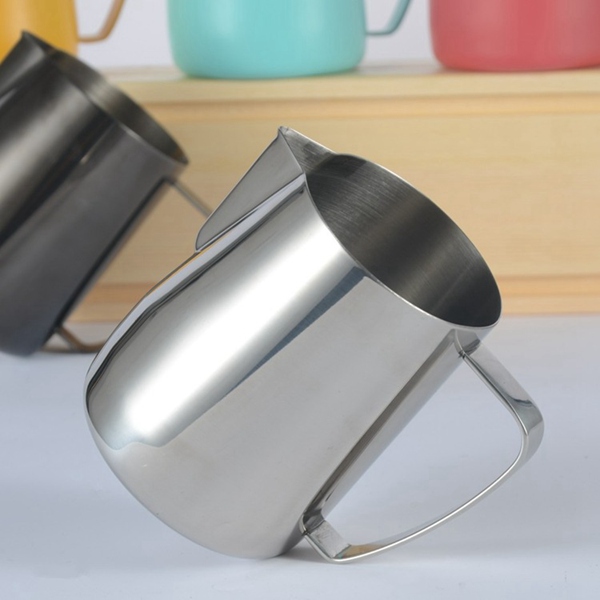
1. What is a frothing pitcher?
A frothing pitcher is a specialized container used for frothing milk or cream for various beverages like espresso, cappuccinos, and lattes. It is typically made of stainless steel, which helps in achieving the desired froth consistency due to its superior heat retention properties.
2. Why do baristas use frothing pitchers?
Baristas use frothing pitchers to create creamy and velvety foam for their coffee creations. The shape and design of the pitcher allow for optimal milk swirling and frothing. The pour spout helps to control the pouring of the milk, allowing for beautiful latte art designs on top of the coffee.
3. How to froth milk without a frothing pitcher?
If you don't have a frothing pitcher, you can still froth milk using a saucepan and a whisk. Heat the milk in the saucepan on low heat, and whisk vigorously in a back-and-forth motion until froth forms. However, using a frothing pitcher is much more convenient and efficient for achieving consistent results.
4. What is the ideal size of a frothing pitcher?
The ideal size of a frothing pitcher depends on personal preference and the number of drinks you wish to make at once. Common sizes range from 12 to 20 ounces. Larger pitchers are suitable for making multiple servings, while smaller ones are better for single servings or creating intricate latte art.
5. Can frothing pitchers be used for other purposes?
While frothing pitchers are primarily designed for frothing milk, they can also be used for other purposes. They can be used as a pouring pitcher for sauces or dressings, as a mixing container for cocktails or batters, or even as a container for serving beverages like water or juice.
6. How to clean a frothing pitcher?
To clean a frothing pitcher, rinse it with warm soapy water immediately after use. Use a sponge or brush to remove any milk residue. Avoid using harsh abrasives that might scratch the surface. If the pitcher has stubborn stains or buildup, a mixture of water and vinegar can be used for soaking before rinsing.
7. Are frothing pitchers dishwasher safe?
Most frothing pitchers are dishwasher safe. However, it is recommended to check the manufacturer's instructions to ensure that the pitcher is suitable for dishwasher use. Using a dishwasher can also help to sanitize the pitcher and remove any lingering odors.
8. Are there different types of frothing pitchers?
Yes, there are different types of frothing pitchers available in the market. Some pitchers have a non-stick coating, which makes it easier to clean. Others have a tapered spout for more precise pouring and latte art. There are also electric frothing pitchers that heat and froth the milk simultaneously.
9. Can frothing pitchers be used on any stovetop?
Most frothing pitchers are compatible with all types of stovetops, including electric, gas, induction, and even microwave. However, it is essential to check the manufacturer's instructions for any specific compatibility requirements.
10. How to achieve the perfect froth consistency?
To achieve the perfect froth consistency, start with cold milk and fill the pitcher only up to one-third of its capacity to allow room for expansion. Position the steam wand of an espresso machine just below the surface of the milk and steam it until it reaches the desired temperature. Practice and experimentation are key to mastering the art of frothing.
11. How long can frothed milk last in a frothing pitcher?
Frothed milk should be used immediately or within a few minutes for optimal taste and texture. It is not recommended to leave frothed milk sitting in a frothing pitcher for an extended period as it can lose its texture and flavor.
12. Why does the size of the pitcher matter for frothing?
The size of the pitcher matters for frothing as it affects the amount of air that can be incorporated into the milk. A larger pitcher with more surface area allows for more air to be introduced, resulting in a frothier texture. However, using an oversized pitcher with a small amount of milk might make it challenging to create enough agitation for proper frothing.
13. Are there any alternatives to frothing pitchers?
Yes, there are alternatives to frothing pitchers. Some espresso machines have a built-in frothing wand, eliminating the need for a separate pitcher. Another option is to use a handheld milk frother or a manual milk frother. These devices are portable and can produce frothed milk without the need for a frothing pitcher.
14. How do professionals create latte art with frothing pitchers?
Professionals create latte art by pouring frothed milk into the espresso in a specific manner. By tilting the frothing pitcher slightly and maintaining a steady pour, they can create the desired patterns and designs on the surface of the coffee. With practice and skill, intricate and artistic latte art can beachieved using a frothing pitcher.